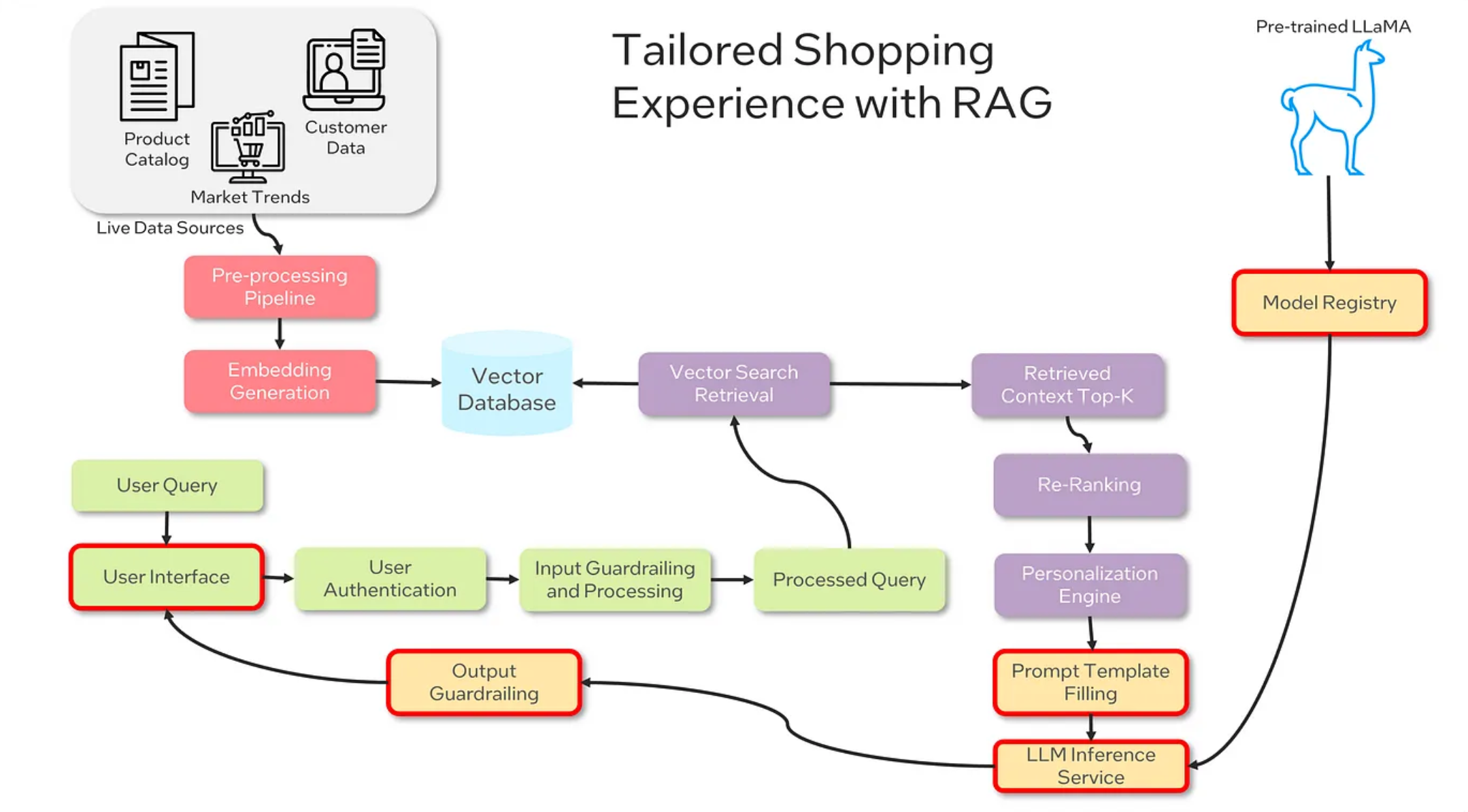Transforming Retail with RAG: The Future of Personalized Shopping
In today’s fast-paced retail environment, traditional recommendation systems face challenges in keeping up with rapidly changing consumer preferences. These systems, which frequently rely on static data and static algorithms, can struggle to adapt to the variability of customer desires and market trends. This shortcoming can lead to a suboptimal shopping experience and a negative impact on retailers’ financial performance through missed sales and reduced customer loyalty.
The RAG-based (Retrieval-Augmented Generation) recommendation system represents a cutting-edge solution to this challenge. By leveraging advanced retrieval techniques, RAG provides up-to-the-minute recommendations tailored to individual customers’ preferences, ensuring that suggestions are as current as the latest Twitter trend and as personal as a handwritten note.
Figure 1. RAG-based Recommendation System Architecture. Live data sources pass through a pre-processing pipeline and embedding model, with the output stored in a vector database. User queries are processed, and the retrieved context from the vector database is re-ranked and personalized, with prompt filling incorporating the retrieved context. The final output is guardrailed and post-processed
The diagram above aims to illustrate the high-level architectural elements of a RAG-based retail recommendation system. We will dive deeper into its various components and flow in this article.
The Challenge of Personalization in Retail
Traditional recommendation engines have long been a staple in e-commerce and brick-and-mortar retail, helping guide customers towards their next purchase. However, their inability to quickly adapt to real-time data and take into account nuanced customer feedback has led to a decrease in the relevance of their suggestions. In an industry where personalization is highly valued, this lack of relevance is a missed opportunity.
Introducing RAG for Retail
The RAG-based (Retrieval-Augmented Generation) recommendation system redefines personalization by dynamically integrating vast amounts of data, from market trends to individual customer interactions, into the recommendation process. This ensures that product suggestions are relevant and timely, enhancing the shopping experience and fostering stronger customer relationships.
For example, when Emma, a shopper, searches for a dress for an upcoming wedding, the RAG-based system generates an embedding from her query and interacts with the vector database to find the best matches. It then re-ranks the top search results based on Emma’s previous purchases and browsing behavior and adapts the suggestions further by considering Emma’s color preferences and past feedback on dress sizes for specific brands.
Emma is presented with a curated selection of dresses that are trend-aligned and tailored to her personal style and preferences. As she interacts with the system, the RAG-based recommendation system learns from her behavior, improving the accuracy of future recommendations. Overall, the RAG-based recommendation system provides a personalized shopping experience that is up-to-date with the latest market trends.
How RAG Works in Retail
The magic of the RAG system unfolds across three primary layers, each playing a pivotal role in delivering personalized product suggestions (Figure 2).
Figure 2. Various layers of our proposed RAG retail application
Data Collection and Integration Layer: This foundational layer aggregates data from diverse sources, including e-commerce platforms, CRM systems, and social media. It ensures a holistic view of customer preferences and market trends, feeding into a centralized data lake alongside a constantly updated product catalog (Figure 3).
Figure 3. Highlighting the Data Collection and Integration Layer of the solution architecture — Image by Author
The RAG Layer: At the heart of the system lies the RAG Layer, where the magic happens. This layer retrieves pertinent information from a vector database, which houses a rich collection of customer preferences, market trends, and product details. It’s here that the system ensures recommendations are both relevant to the current market and personalized to the individual (Figure 4).
Figure 4. Highlighting the RAG Layer of the solution architecture
Recommendation Generation and Personalization: Armed with insights from the RAG layer, the system dynamically generates personalized product suggestions. These recommendations are fine-tuned based on the customer’s historical data and preferences, ensuring a tailored shopping experience (Figure 5).
Figure 5. Highlighting the Recommendation Generation and Personalization of the solution architecture — Image by Author
Benefits of RAG in Retail
The implementation of a RAG-based recommendation system heralds numerous benefits for retailers. Most notably, it drives sales and fosters customer loyalty through improved satisfaction. By delivering timely and relevant product suggestions, retailers can ensure their offerings resonate with customers, encouraging repeat visits and purchases (Figure 6).
Figure 6. Highlighting the key benefits of RAG in retail
Summary and Discussion
As the retail industry evolves, technologies like RAG (Retrieval-Augmented Generation) are becoming increasingly important for retailers who want to stay competitive.
RAG has the potential to transform retail by providing real-time, personalized recommendations that are tailored to individual customers’ preferences, market trends, product inventories, etc. By leveraging these solutions and techniques, retailers can provide a more engaging and personalized shopping experience, which can lead to increased customer loyalty and revenue.






